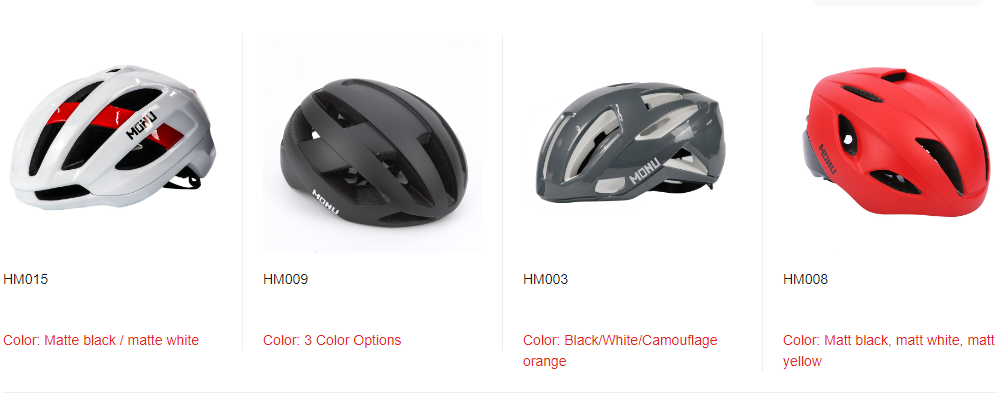Explore Our Selection of Road Bike Helmets for Sale: Find Your Perfect Fit Today!

Road biking is a thrilling outdoor activity that requires proper safety gear, especially helmets. A road bike helmet is essential to protect the head from potential injuries during an accident. Finding the right helmet can be a daunting task, but with the right information, it can be an easy and enjoyable experience.
At monusports, they offer a wide selection of road bike helmets for sale. From beginner to professional riders, they have a helmet that suits every need and budget. Their helmets are designed to provide maximum protection, comfort, and style. Whether you prefer a lightweight, aerodynamic, or well-ventilated helmet, they have it all.
The Importance of a Proper Fit
When it comes to road bike helmets, finding the right fit is crucial for both comfort and safety. A helmet that is too loose or too tight can not only be uncomfortable but also ineffective in protecting the head in case of an accident. Here are some key factors to keep in mind when choosing a road bike helmet:

Measuring Your Head Size
Before purchasing a helmet, it’s important to measure your head size to ensure a proper fit. To do this, use a soft tape measure and wrap it around the widest part of your head, just above the eyebrows and ears. Make sure the tape measure is snug but not too tight. Once you have your measurement, refer to the manufacturer’s sizing chart to find the appropriate helmet size.
It’s worth noting that different helmet brands may have slightly different sizing charts, so it’s important to double-check before making a purchase. Additionally, some helmets come with adjustable sizing systems, which can help fine-tune the fit even further.
Adjustment Systems
Even with the right size, a helmet may still need some adjustments to ensure a secure and comfortable fit. Most road bike helmets come with some form of adjustment system, whether it’s a dial or a set of straps. These systems allow you to adjust the fit of the helmet to your specific head shape and size.
One common adjustment system is a dial at the back of the helmet, which can be tightened or loosened to achieve a snug fit. Another is a set of straps that can be adjusted to ensure the helmet is sitting level on the head. It’s important to take the time to adjust these systems properly to ensure a secure fit.
In summary, finding the right fit for a road bike helmet is crucial for both comfort and safety. Measuring your head size and using the manufacturer’s sizing chart can help ensure you’re getting the right size, while adjustment systems can help fine-tune the fit to your specific head shape and size.
Safety Standards and Certifications
When it comes to road bike helmets, safety is of utmost importance. In order to ensure that the helmets meet certain safety standards, there are various certifications that they must obtain. Here are the two main safety standards and certifications that you should look for when considering a road bike helmet:
CPSC Standards
The Consumer Product Safety Commission (CPSC) is a U.S. government agency that regulates the safety of consumer products. In order for a road bike helmet to be sold in the U.S., it must meet the CPSC’s safety standards. This includes requirements for impact resistance, strap strength, and more. Look for a CPSC sticker or label on the helmet to ensure that it meets these standards.
CE EN1078 Certification
The CE EN1078 certification is a European standard for bicycle helmets. In order to obtain this certification, a helmet must meet certain safety requirements for impact resistance, retention system strength, and more. Look for a CE EN1078 sticker or label on the helmet to ensure that it meets these standards.
It is important to note that while these certifications ensure a certain level of safety, they do not guarantee complete protection from all types of head injuries. It is still important to use caution and ride safely when cycling.
Materials and Technology
In-Mold Construction
One of the most common construction methods for road bike helmets is in-mold construction. This process involves fusing the outer shell of the helmet with its inner foam core during manufacturing. The result is a single, cohesive unit that is both lightweight and durable. In-mold construction also allows for a sleeker and more aerodynamic design, making it a popular choice among road cyclists.
MIPS Technology
MIPS (Multi-directional Impact Protection System) is a technology that is becoming increasingly popular in road bike helmets. It works by adding a low-friction layer between the helmet and the head, which allows the helmet to rotate slightly upon impact. This rotation can help reduce the rotational forces that can cause brain injuries in the event of a crash.
Many road bike helmets now feature MIPS technology, and it is often touted as a major selling point. However, it is important to note that the effectiveness of MIPS in reducing brain injuries has not yet been definitively proven. Nonetheless, many cyclists feel that the added protection is worth the extra cost.
Overall, the materials and technology used in road bike helmets are constantly evolving, with new innovations being introduced every year. Whether you prioritize aerodynamics, safety, or style, there is sure to be a helmet out there that meets your needs.
Style and Aerodynamics
When it comes to road bike helmets, style and aerodynamics are two important factors to consider. A good helmet not only provides protection but also enhances the overall look of the rider.
Visor or No Visor
One of the most noticeable differences between road bike helmets is the presence or absence of a visor. A visor is a piece of plastic that extends from the front of the helmet to shield the eyes from the sun and wind. Some riders prefer helmets with visors for their added protection and convenience, while others prefer helmets without visors for their sleek and aerodynamic design.
Ventilation and Airflow
Another important factor to consider when choosing a road bike helmet is ventilation and airflow. A well-ventilated helmet allows air to circulate around the rider’s head, keeping them cool and comfortable during long rides. Look for helmets with multiple vents and channels that promote airflow and prevent heat buildup.
Overall, choosing a road bike helmet that balances style and aerodynamics with safety and comfort is key. Consider factors such as visors and ventilation when browsing through our selection of road bike helmets for sale.
Top Brands and Models

Premium Road Bike Helmets
For the serious cyclist who demands the best, there are several premium road bike helmet brands and models to choose from. These helmets offer top-of-the-line protection, comfort, and style.
One of the most popular premium road bike helmet brands is Giro. Their helmets are known for their sleek design and advanced safety features. The Giro Aether MIPS helmet is a top pick for its excellent ventilation and MIPS technology, which helps reduce rotational forces in the event of an impact.
Another premium brand to consider is Kask. Their helmets are known for their lightweight design and exceptional aerodynamics. The Kask Protone helmet is a top choice for its excellent ventilation and comfortable fit.
Budget-Friendly Choices
For those on a budget, there are still plenty of great road bike helmet options available. These helmets may not have all the bells and whistles of premium models, but they still offer reliable protection and comfort.
One budget-friendly brand to consider is Bell. Their helmets are known for their affordability and durability. The Bell Stratus MIPS helmet is a top pick for its MIPS technology and comfortable fit.
Another great budget-friendly option is the Schwinn Thrasher helmet. This helmet offers excellent ventilation and a lightweight design at an affordable price.
Overall, whether you’re looking for a premium road bike helmet or a budget-friendly option, there are plenty of great brands and models to choose from. It’s important to prioritize safety and comfort when selecting a helmet, and to choose a helmet that fits well and meets your specific needs as a cyclist.
Frequently Asked Questions
How do I determine the correct size for my road bike helmet?
It’s essential to get the right size for your road bike helmet to ensure maximum protection. To determine the correct size, measure the circumference of your head just above your eyebrows and ears. Then, refer to the helmet size chart provided by the manufacturer to find the right size for you. It’s important to note that different brands may have slightly different sizing, so always refer to the manufacturer’s size chart.
What are the safety features to look for in a high-quality road bike helmet?
A high-quality road bike helmet should have several safety features to ensure optimal protection. Look for helmets that have a sturdy outer shell, a thick layer of impact-absorbing foam, and a secure fit system to keep the helmet in place during a crash. Additionally, helmets with MIPS (Multi-directional Impact Protection System) technology provide added protection against rotational forces, which can cause brain injuries.
How often should a road bike helmet be replaced for optimal safety?
It’s recommended to replace your road bike helmet every three to five years, depending on usage and wear. If you’ve been in a crash, replace your helmet immediately, even if there is no visible damage. The foam in the helmet can be compressed during a crash, and it may not provide adequate protection in another crash.
Are there significant differences between aero helmets and standard road bike helmets?
Aero helmets are designed to reduce drag and improve aerodynamics, making them popular among competitive cyclists. They typically have a more streamlined shape and fewer vents than standard road bike helmets. However, aero helmets may sacrifice ventilation and may not be as comfortable for longer rides. Standard road bike helmets provide excellent protection and ventilation, making them a great choice for most cyclists.